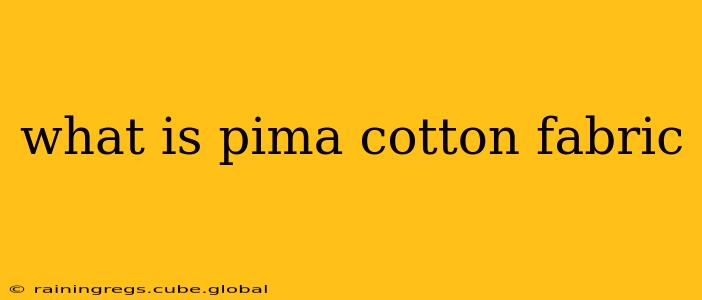Pima cotton fabric is renowned for its exceptional softness, strength, and luxurious feel. But what exactly makes it stand out from other types of cotton? This comprehensive guide explores the characteristics, benefits, uses, and care of Pima cotton, answering many frequently asked questions.
What Makes Pima Cotton Different?
Pima cotton, also known as extra-long staple (ELS) cotton, distinguishes itself through its exceptionally long fibers. These fibers are significantly longer than those found in standard cotton, typically measuring 1 1/8 inches or more. This length is crucial; longer fibers create stronger, smoother, and more durable yarns. The result? A fabric that's incredibly soft against the skin, drapes beautifully, and resists pilling and wear much better than standard cotton.
Where Does Pima Cotton Come From?
Pima cotton plants are primarily cultivated in specific regions with ideal climates, including:
- The Southwestern United States (Arizona, California): This region is famous for producing high-quality Pima cotton.
- Peru: Peruvian Pima cotton is also highly regarded for its superior fiber length and strength.
- Egypt: Egyptian Pima cotton, often called "Egyptian cotton," is another well-known variety, contributing to the region's reputation for fine textiles.
The specific growing conditions in these regions, including the sunlight, water, and soil, contribute significantly to the cotton's quality.
Is Pima Cotton Better Than Other Cottons?
Yes, Pima cotton generally offers superior qualities compared to regular cotton. Here's a comparison:
| Feature | Pima Cotton | Regular Cotton |
|---|---|---|
| Fiber Length | Extra-long staple (1 1/8" +) | Shorter staple |
| Softness | Exceptionally soft | Less soft |
| Strength | Stronger, more durable | Less durable, prone to wear |
| Lustre | More lustrous, shiny | Less lustrous |
| Durability | Highly durable, resists pilling | Less durable, prone to pilling |
| Price | More expensive | Less expensive |
What is the difference between Pima and Supima cotton?
Supima is actually a trademarked name for American-grown Pima cotton. All Supima cotton is Pima cotton, but not all Pima cotton is Supima. The Supima brand guarantees the cotton has met specific quality standards regarding fiber length, strength, and uniformity.
How is Pima Cotton Fabric Used?
The exceptional properties of Pima cotton make it ideal for a wide range of applications:
- High-end clothing: T-shirts, underwear, sheets, towels, and other apparel where softness, comfort, and durability are paramount.
- Luxury home textiles: High-thread-count sheets, pillowcases, and blankets known for their luxurious feel and longevity.
- Medical textiles: Pima's hypoallergenic nature makes it suitable for bandages and other medical applications.
How to Care for Pima Cotton Fabric?
To maintain the quality and longevity of your Pima cotton garments and textiles, follow these care instructions:
- Washing: Wash in cold or lukewarm water.
- Drying: Tumble dry on low heat or hang to dry for optimal results. High heat can damage the fibers.
- Ironing: Iron at a low setting, if necessary.
Is Pima Cotton Sustainable?
While Pima cotton cultivation requires more resources than some other crops, sustainable practices are increasingly being adopted by Pima cotton farmers. These efforts include reducing water usage, using fewer pesticides, and promoting biodiversity. Look for certifications that confirm sustainable practices, like organic certification, when choosing Pima cotton products.
In conclusion, Pima cotton fabric offers a unique combination of luxury, durability, and sustainability, making it a highly desirable choice for clothing, home textiles, and more. By understanding its characteristics and care instructions, you can enjoy its exceptional qualities for years to come.
